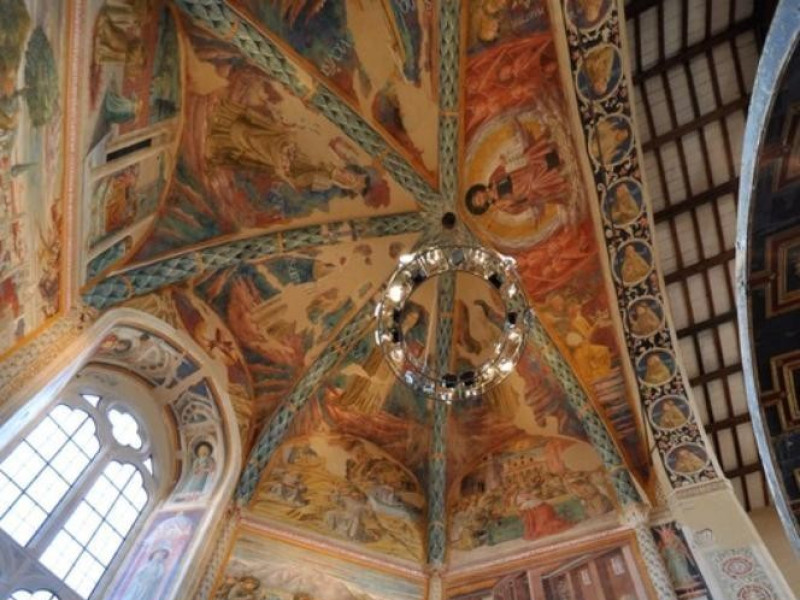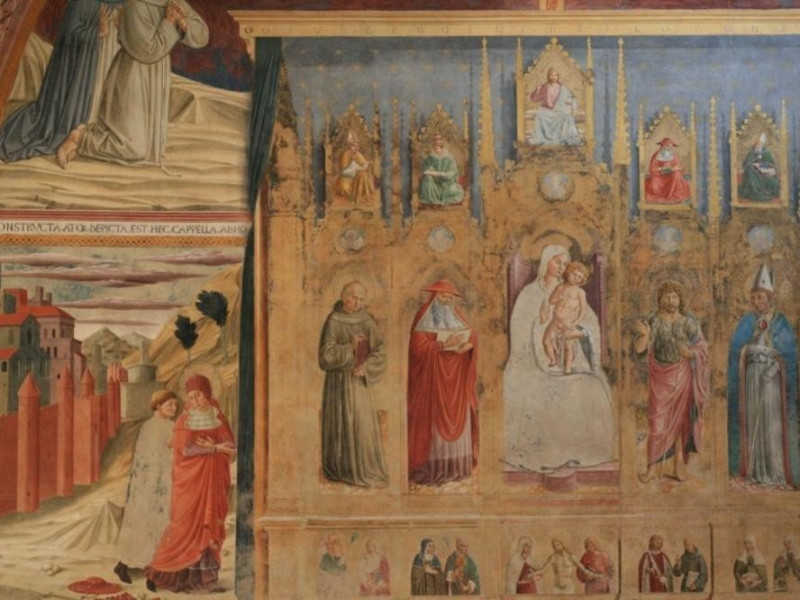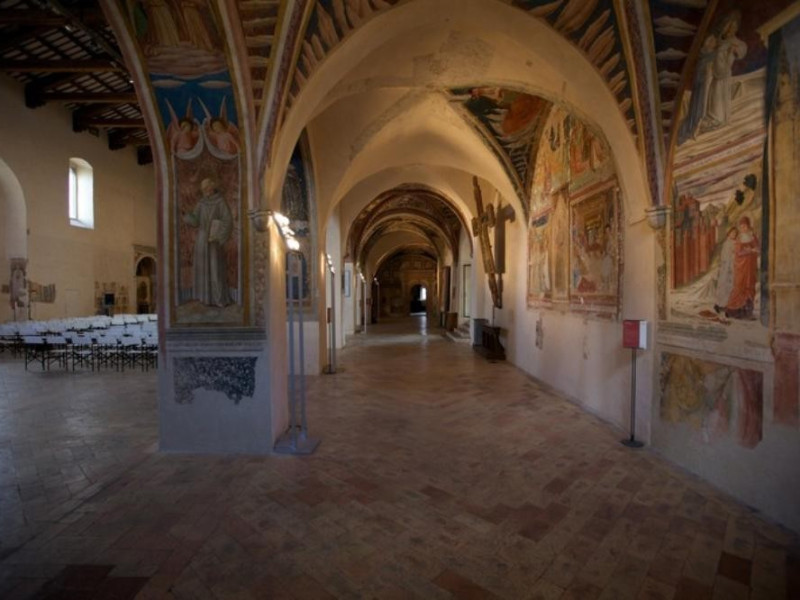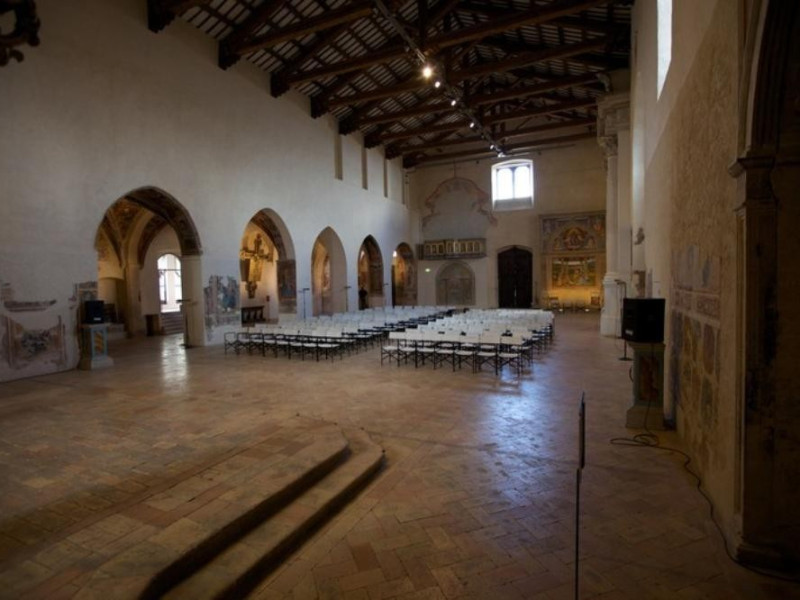Luogo - Religious building
Chiesa e Convento di S. Francesco
Where
Montefalco (Perugia)
The Church of San Francesco
The church is located in the city center of Montefalco, in the area between the ancient wall surrounding the town and the one built in 1328, in Via Ringhiera Umbra.
It was built by the Franciscan Friars of the Minor Order, around 1340. It was only later that the six chapels on the right side were added, probably in the late 14th-early 15th century.
A chapel was opened on the left side of the church, as desired by the Provincial Minister of the Minor Friar, Clemente Bontadosi, around 1585. The chapel has an imposing front elevation, with two lateral Corinthian jamb columns. The entablature, decorated with spirals supporting the tympanum, is framed with a broken triangular pediment. In 1876, the architect Francesco Salviati da Montefalco realized the façade coating and opened the bifora—a double lancet or mullioned window. Further restoration work carried out in 1889 led to the demolition of the Baroque altars and the redoing of the roof trusses.
In 1863, the church became property of the Municipality of Montefalco, and in 1895 it was adapted as an Art Gallery; the restoration work carried out at the end of the 20th century allowed its reopening to the public.
The façade, coated with slabs of a light stone, has the shape of a cabin underlined by two lateral lesene pilasters; at the center of the façade an arch frames the portal; it is delimited by two lesenes—featuring two columns with their rosette-molded capital—that stand on a high base under a classical trabeation with triglyph and metope supporting a triangular tympana. Above, there is a bifora opened in 1876.
The interior of the church shows an initially planned single nave, which ends with a polygonal apse and two squared chapels; on the right side there are six interconnected chapels, while on the left side there is only one. The roof above the nave is wood-trussed, while the chapels are covered by cross vaults, and the apse has a bevel dome. The dome of the apse is supported by rib vaults ending on sculpted corbels with faces of females, a bishop face, a friar face and the head of an eagle and that of a lion; on the central wall of the apse a two order double lancet window provides light for the nave. The vaults of the chapels are also ribbed and the corbels are decorated with sculpted foliage.
On the nave to the right, there is the first chapel on the first bay. This is St Jerome Chapel, frescoed between 1450 and 1452 by Benozzo Gozzoli. It is the first majestic cycle of frescoes executed autonomously by the Florentine painter, who was thirty at the time, and had been a fellow worker of Beato Angelico for years. On the main wall a fake polyptych depicts a Madonna with Child and the SS Anthony of Padua, Jerome, John the Baptist Louis of Toulouse; above a Crucifixion and Saints and two Episodes of the Life of St Jerome; in the vault the Four Evangelists and other fragmentary scenes of the Life of the Saint. Under the arch, a Blessing Christ with Angels, SS Bernardino of Siena, Catherine of Alexandria, Jerome in the Desert and Sebastian are depicted.
In the second bay there is St Bernardino Chapel with frescoes of Jacopo Vincioli (1461).
Under the third bay there is the Chapel of the Crucifix, which preserves a painted and cross shaped Crucifix with the Virgin and St John the Evangelist and on the sides St Francis at the Feet of Christ, work of the Expressionist Master of Santa Chiara.
The fourth bay preserves the chapel dedicated to the Assumption of Mary with frescoes of Giovanni Corraduccio and his workshop.
The fifth bay Chapel, dedicated to St Anthony Abbot, has frescoes attributed to Giovanni di Corraduccio and his workshop and a wooden panel painted by Tiberio d’Assisi depicting The Madonna of the Succour (1510).
From the sixth bay, through a wooden door realized in 1610, it is possible to enter into the Chapel of the Annunciation, which has frescoes of Giovanni di Corraduccio and his workshop.
The apse on the right preserves the frescoes of the Master of the Apse of Montefalco; the central polygonal apse frescoed, with Scenes of the Life of St Francis by Benozzo Gozzoli, in 1452.
In the intrados, there is St Francis and The Twelve Apostles painted inside the so-called tondi—a round frame; on the vault The Glory of St Francis and SS Anthony of Padua, Clare, Bernardino from Siena, Elisabeth of Alexandria and Louis of Toulouse. On the walls, The Scenes of Life of St Francis is told from the lowest row to the left.
It is worth noting the niche in the counter façade, to the right of the main portal, where The Nativity surmounted by The Annunciation and a Blessing Christ, were frescoed by Perugino in 1503.






